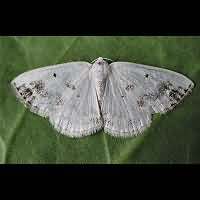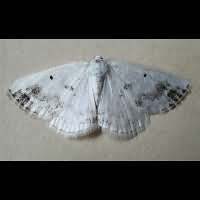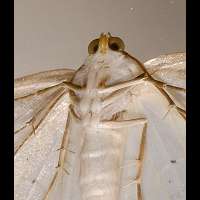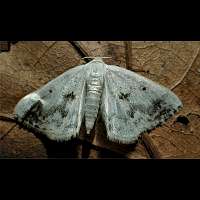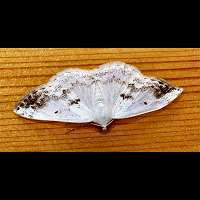Clouded Silver (Lomographa temerata)
The Clouded Silver is unmistakable: a white moth showing some black smears, especially near the tip of the forewings. The amount of smears and the intensity is highly variable however. But in spite of that easily identified. Usually the females are marked more weakly than the males are. The females have wire-like antennae, while those of the male are feathered. Having a wingspan of 27 to 33 mm this is quite a typical Geometer Moth.
Females of the Clouded Silver deposit their eggs in May and June. The eggs are laid in crevices in tree barks or on or near buds. After two or three weeks the eggs hatch. The caterpillars are clearly bicoloured. The top side is blueish green, the downside is whitish green. There are red dots on the back. These sometimes merge into a red dorsal line. On both sides of these dots or this line are smaller white dots. The head is green with two brown spots. In autumn the caterpillars go to the ground to pupate in a thin cocoon on the ground or in it. The Clouded Silver overwinters as a pupa. The caterpillars grow to a length of some 30 mm. They can be found on a great number of trees and shrubs, especially Bird-Cherry, Plumb and Luge Thorn.
The Clouded Silver is on the wing from mid-May to Mid-July. Sporadically seen several weeks earlier or later. Starts flying in dusk and is then often seen in gardens. During daytime regularly found resting on tree trunks or walls. Comes to light easily. A common species in woodlands, parks and big gardens all over England and Wales, but getting scarcer northwards. Local in Southern Scotland, not in Northern Scotland. Visitor to parks and gardens, including those in cities. Elsewhere in Europe equally common, but not in Northern parts of Scandinavia.
The Clouded Silver is unmistakable: a white moth showing some black smears, especially near the tip of the forewings. The amount of smears and the intensity is highly variable however. But in spite of that easily identified. Usually the females are marked more weakly than the males are. The females have wire-like antennae, while those of the male are feathered. Having a wingspan of 27 to 33 mm this is quite a typical Geometer Moth.
Females of the Clouded Silver deposit their eggs in May and June. The eggs are laid in crevices in tree barks or on or near buds. After two or three weeks the eggs hatch. The caterpillars are clearly bicoloured. The top side is blueish green, the downside is whitish green. There are red dots on the back. These sometimes merge into a red dorsal line. On both sides of these dots or this line are smaller white dots. The head is green with two brown spots. In autumn the caterpillars go to the ground to pupate in a thin cocoon on the ground or in it. The Clouded Silver overwinters as a pupa. The caterpillars grow to a length of some 30 mm. They can be found on a great number of trees and shrubs, especially Bird-Cherry, Plumb and Luge Thorn.
The Clouded Silver is on the wing from mid-May to Mid-July. Sporadically seen several weeks earlier or later. Starts flying in dusk and is then often seen in gardens. During daytime regularly found resting on tree trunks or walls. Comes to light easily. A common species in woodlands, parks and big gardens all over England and Wales, but getting scarcer northwards. Local in Southern Scotland, not in Northern Scotland. Visitor to parks and gardens, including those in cities. Elsewhere in Europe equally common, but not in Northern parts of Scandinavia.

